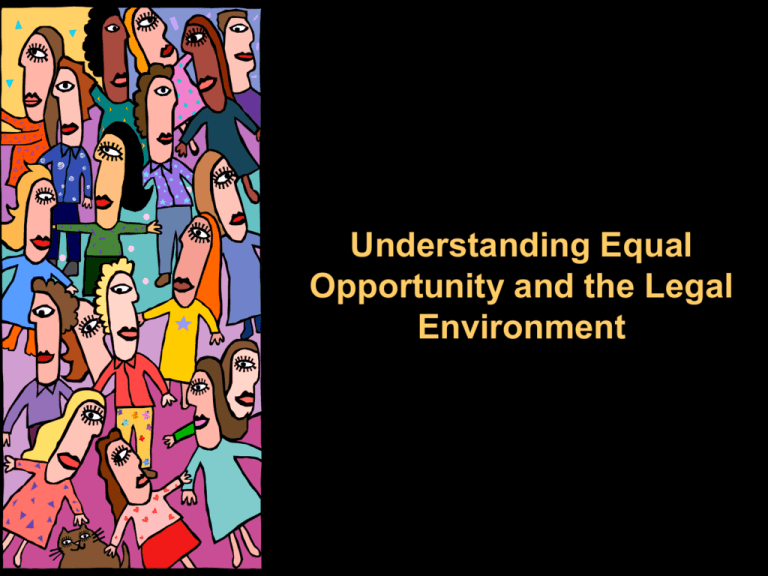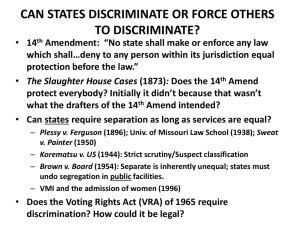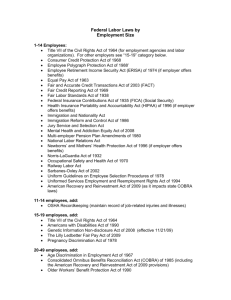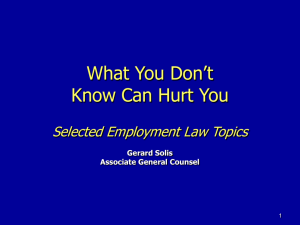Equal Employment Opportunity Laws – Title VII Civil Rights Act 1964
advertisement

Understanding Equal Opportunity and the Legal Environment Why Understanding the Legal Environment is Important • It is the right thing to do… • Helps to understand the limitations of the HR and Legal departments • Facilitate a fair and humane environment • Can limit potential liability • Avoid creating a negative image for a company Challenges to Legal Compliance • Dynamic legal landscape • Complexity of laws Challenges to Legal Compliance (Cont.) •Conflicting Strategies for fair employment • Equal Employment Opportunity Laws – Equal Pay Act 1963 Competitive Position: Cost, • Requires that male and female workers receive equal pay for work requiring equal skill, effort and responsibility, and performed under similar working conditions • Challenges: • Determining whether 2 employees are doing same job • Exceptions: • • • • Merit Pay Varying quality/quality of work Seniority plans Geographic regions Equal Employment Opportunity Laws – Title VII Civil Rights Act 1964 • General Provisions: • Prohibits discrimination based upon a person’s race, color, religion, sex or national origin • Theory of Protected Class - group of people who have suffered discrimination in the past and who are given special protection by the judicial system: – – – – – African Americans Asian Americans Latinos Native Americans Women Equal Equal Employment Employment Opportunity Opportunity Laws – Title VII CivilLaws Rights (Cont.) Act 1964 (Cont.) Two Types of Illegal Discrimination Disparate Treatment Intentional discrimination, when an employer treats an employee differently because of their protected status Disparate Impact Equal application of an employment standard that has an unequal effect on one or more in a protected class (adverse impact) Equal Equal Employment Employment Opportunity Opportunity Laws – Title VII CivilLaws Rights (Cont.) Act 1964 (Cont.) Disparate Impact Important Cases: Griggs v. Duke Power Company: Supreme Court case in which the plaintiff argued that his employer’s requirement that coal handlers be high school graduates was unfairly discriminatory. In finding for the plaintiff, the Court ruled that discrimination need not be overt to be illegal, that employment practices must be related to job performance, and that the burden of proof is on the employer to show that hiring standards are job related. •Discrimination by the employer need not be overt; employer’s intent is irrelevant. •An employment practice must be job related and valid if it has an unequal impact on members of a protected class. •The burden of proof is on the employer to show that the employment practice is job related. Equal Equal Employment Employment Opportunity Opportunity Laws – Title VII CivilLaws Rights (Cont.) Act 1964 (Cont.) Disparate Impact Important Cases (Cont.): Albemarle Paper Company v. Moody: Reaffirmed the idea that any test used in the selection process or in promotion decisions must be validated if it is found that its use has had an adverse impact on women and minorities •If an employer uses a test to screen candidates, then the job’s specific duties and responsibilities must be carefully analyzed and documented •The performance standards for employees on the job in question should be clear and unambiguous •Test must be a valid predictor of job performance, burden on employer •EEOC (now federal) guidelines on validation are to be used for validating employment practices Equal Equal Employment Employment Opportunity Opportunity Laws – Title VII CivilLaws Rights (Cont.) Act 1964 (Cont.) Defense of Discrimination Charges: Burden on employee to prove there is a Prima Facie case: McDonnell Douglas Test to Establish a Prima Facie (legally sufficient) Case of Discrimination: •The person is a member of a protected class •The person applied for a job for which he or she was qualified •The person was rejected, despite being qualified •After rejection, the employer continued to seek other applicants with similar qualifications Equal Equal Employment Employment Opportunity Opportunity Laws – Title VII CivilLaws Rights (Cont.) Act 1964 (Cont.) Defense of Discrimination Charges: Burden on employee to prove there is a Prima Facie case: •Restricted company policy: Plaintiff proves that the company has a formal policy that restricts the selection of a protected group. •Discriminatory remarks: Plaintiff must produce evidence that certain biased remarks were made by the employer regarding the protected group. Equal Equal Employment Employment Opportunity Opportunity Laws – Title VII CivilLaws Rights (Cont.) Act 1964 (Cont.) Defense of Discrimination Charges (Cont.): Four-Fifths Rule: •EEOC’s Uniform Guidelines on Employee Selection Procedures •A selection rate for any race, sex, or ethnic group which is less than four-fifths or 80 percent of the rate for the group with the highest rate generally is regarded as evidence of adverse impact Equal Equal Employment Employment Opportunity Opportunity Laws – Title VII CivilLaws Rights (Cont.) Act 1964 (Cont.) Defense of Discrimination Charges (Four-Fifths Rule): Equal Equal Employment Employment Opportunity Opportunity Laws – Title VII CivilLaws Rights (Cont.) Act 1964 (Cont.) Defense of Discrimination Charges – Employer Burden Job Relatedness: BFOQ: • Business can show that the decision was made for job- related reasons. • Bona Fide Occupational Qualification. Requirement that an employee be of a certain religion, sex, or national origin where that is reasonably necessary to the organization’s normal operation. Argues all or nearly all, authenticity, propriety, or safety defense • Formal seniority systems are permitted - must be well established and applied universally Seniority: Business necessity: Discriminatory Remarks • Defense created by the courts, which requires an employer to show an overriding business purpose for the discriminatory practice and that the practice is therefore acceptable. (drug testing) • Requires the employer to argue that the remarks were not very derogatory or that the person who made the remarks had no influence on the hiring decision Equal Equal Employment Employment Opportunity Opportunity Laws – Title VII CivilLaws Rights (Cont.) Act 1964 (Cont.) Pregnancy Act of 1978: A Title VII amendment that prohibits sex discrimination based on “pregnancy, childbirth, or related medical conditions.” •An employer must treat pregnancy and childbirth like any other medical condition •Must include pregnancy related conditions in benefit plan if other conditions are allowed Equal Equal Employment Employment Opportunity Opportunity Laws – Title VII CivilLaws Rights (Cont.) Act 1964 (Cont.) Title VII has been interpreted to prohibit sexual harassment: •Harassment on the basis of sex that has the purpose or effect of substantially interfering with a person’s work performance or creating an intimidating, hostile, or offensive work environment •Employers have an affirmative duty to maintain workplaces free of sexual harassment and intimidation Civil Right Act of 1991 Burden of Proof Quotas • Once plaintiff shows disparate impact (prima facie case) , the employer has the burden of proving that the challenged practice is job related • Explicitly forbidden Damages & Jury Trails • permits compensatory and punitive damages makes it easier to sue for money damages in certain cases Expanded Coverage • amending the definition of employee to mean a U.S. citizen employed in a foreign country by a U.S.-owned or -controlled company Other EEO Laws •Immigration Reform and Control Act of 1986 •Genetic Information Nondiscrimination Act (2008) Age Discrimination in Employment Act of 1967 (ADEA) •The act prohibiting arbitrary age discrimination and specifically protecting individuals over 40 years old •Majority of complaints come from terminated workers •Amendment to ADEA – Older Workers’ Protection Act of 1990: •Illegal for employers to discriminate by providing benefits to employees based on age Americans With Disabilities Act of 1990 (ADA) People with disabilities Forbids Employment Discrimination Against Who are able to perform the essential functions of the job With or without reasonable accommodation Americans With Disabilities Act of 1990 (ADA) (Cont.) Individual with a Disability = A person with a physical or mental impairment that substantially affects one or more major life activities Americans With Disabilities Act of 1990 (ADA) (Cont.) Essential Functions = Job duties that each person in a certain position must do or be able to do to be an effective employee vs. marginal functions Americans With Disabilities Act of 1990 (ADA) (Cont.) Reasonable Accommodation = If the individual can’t perform the job as currently structured, the employer must make a “reasonable accommodation” unless doing so would present an “undue hardship.” EEO Enforcement and Compliance The Equal Employment Opportunity Commission (EEOC): •Consists of five members appointed by the President with the advice and consent of the Senate •Each member serves a five-year term •The EEOC has a staff of thousands to assist it in administering the Civil Rights law in employment settings •EEOC may file discrimination charges and go to court on behalf of aggrieved individuals. EEO Enforcement and Compliance (Cont.) The Office of Federal Contract Compliance Programs (OFCCP): •Carries out Executive Order 11246 •Similar to EEOC except: •Monitors compliance with regulations •Great enforcement power EEO Enforcement and Compliance (Cont.) Affirmative Action Programs - applies to organizations who are government contractors or subcontractors EEO Enforcement and Compliance (Cont.) •Affirmative action programs aim to redress past discrimination against protected classes and correct racial and gender imbalances in the workforce. •It attempts to accomplish this aim through initiatives that are ‘‘color-conscious.’’ •Some firms are under no obligation to implement affirmative action programs. EEO Enforcement and Compliance (Cont.) Affirmative action is implemented through two primary steps: •Utilization analysis •Developing an affirmative action plan (AAP) EEO Enforcement and Compliance (Cont.) Utilization analysis •A statistical procedure that compares the percentage of each protected group for each job category within the organization to that in the available labor market. •If the organizational percentage is less than the labor market percentage, the group is classified as being “underutilized.” EEO Enforcement and Compliance (Cont.) Affirmative action plan (AAP) •Affirmative action plans target the underutilized protected groups. •An AAP is a written statement that specifies how the organization plans to increase the utilization of targeted groups. •The AAP consists of three elements – goals, timetables, and action steps. •An AAP practice sometimes involves the use of preferential treatment. Avoiding EEO Pitfalls •Providing training – supervisors, managers and executives •Communication plan to employees explaining commitment to a discrimination-free work environment •Establish a complaint resolution procedure •Document decisions •Be honest






